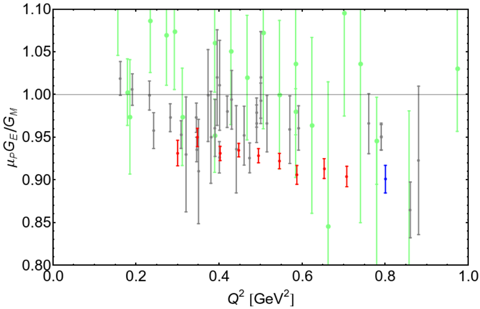In particular we are co-leading an experimental effort to precisely measure the proton form factors at very low energies. These form factors are parameters which describe the electromagnetic structure of the proton in the ground state. These parameters cannot currently be calculated from first principles, and must be experimentally measured. There is more than one way to define the form factors, but the usual one, and the one most convenient for experiment and which has the clearest theoretical interpretations defines the electric (GE) and magnetic (GM) form factors which are related to the charge and magnetization distributions in the proton. We have been using a set of experimental techniques, based on scattering polarized electrons of a proton (hydrogen) target in order to measure the ratio of these two form factors.
This experiment, as well as most others we run are conducted at the Thomas Jefferson National Accelerator Facility (JLab), an electron accelerator located in Newport News, Virginia. The JLab accelerator is quite unique in that it can provide a high current beam of highly polarized electrons. The JLab facility has three experimental areas (halls), which can run independent experimental program. Hall A, where we usually work, is instrumented with two high precision detectors and can accommodate a wide range of additional detector as well as various target systems.
Recently, we concluded the first part of our experiment, in which we scattered polarized electrons off an unpolarized proton target, and then measured the polarization of the recoil proton. The polarization components are directly related to the form factors in such a way that taking the ratio of the polarization components is proportional to the ratio of the form factors. This method allows an extremely clean extraction of the form factor ratio, with an uncertainty of ~1%, better than any other measurement ever done. The graph shows the form factors ratio from various measurements, the red data points are our newest results, the quality of the results is evident

The second part of our experiment, which is scheduled for late 2011, will use a polarized electron beam scattered of a polarized proton target. By orienting the target polarization direction at an angle to the electron beam direction and detecting the scattered electrons in both detectors (which will be symmetrically placed) we are able to remove most of the systematic uncertainties in order to get an extremely precise measurement. The figure below shows the accuracy we expect to achieve for the second part of the experiment, the magenta points show the expected uncertainty.

References:
- G. Ron et al., The Proton Elastic Form Factor Ratio μpGE/GM at Low Momentum Transfer, PRL 99, 202002 (2007)
- G. Ron et al., Low Q2 Measurements of the Proton Form Factor Ratio μpGE/GM , Phys. Rev. C84, 055204 (2011).
- X. Zhan et al., High Precision Measurement of the Proton Elastic Form Factor Ratio μpGE/GM at low Q2, Phys. Lett. B705, 59 (2011).
- G. Ron, et al., Measurement of the Proton Elastic Form Factor Ratio at Low Q2, Jefferson Lab Experiment E08-007 (2008)
- G. Miller, E. Piasetzky, and G. Ron, Proton Electromagnetic Form Factor Ratios at Low Q2, PRL 101, 082002 (2008)